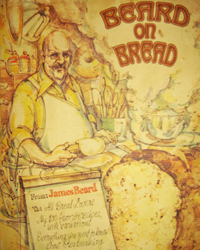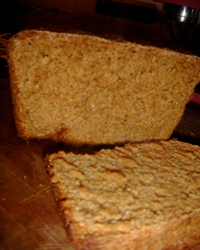Welcome to our maiden voyage into James Beard's Recipe Box, where JBF editors and guest writers will report on their experiences preparing recipes from James Beard's timeless cookbooks.
Our first contributor is Moira Campbell, who attempts Myrtle Allen's brown bread from Beard on Bread. (If she inspires you to give this bread a shot, you can find the recipe here.)
 The thought of making my own bread takes me back to culinary school, where I studied with a Swiss master baker. He taught me how to feed a sourdough starter, slice baguettes with a razor, and to be patient—very, very patient. But what if I wanted to make my own delicious bread in a few hours, minus the time-consuming proofing, rising, and steaming? James Beard was going to teach me how.
My copy of the simply titled Beard on Bread survived a trip from Indiana, where my boyfriend’s grandmother had made bread from its pages countless times. A note on the cover reads:
The thought of making my own bread takes me back to culinary school, where I studied with a Swiss master baker. He taught me how to feed a sourdough starter, slice baguettes with a razor, and to be patient—very, very patient. But what if I wanted to make my own delicious bread in a few hours, minus the time-consuming proofing, rising, and steaming? James Beard was going to teach me how.
My copy of the simply titled Beard on Bread survived a trip from Indiana, where my boyfriend’s grandmother had made bread from its pages countless times. A note on the cover reads:
 I left the dough in a warm spot and an hour later it was ready to be baked. Another helpful note from Beard suggests that the bread be removed from the pan after baking and left on a rack inside the turned-off oven for 20 minutes, which produces “a crustier finish.” Boy, was he right!
I could hardly wait for the bread to cool. Pulling my shiny knife from its magnetic perch, I cut into the loaf. Its crusty exterior gave some resistance, only to reveal a perfect, soft, brown-bread crumb. The end result was a well-textured bread with a rich, nutty flavor. I happily ate a slice of my warm loaf of homemade bread slathered in sweet butter—just as James Beard had instructed.
Moira Campbell is the founder of Rum & Blackbird Tasting Tours. When she is not leading food tours, she can be found dining out in New York’s newest restaurants, catering small fêtes, or scouring the city’s flea markets for vintage cookware.
I left the dough in a warm spot and an hour later it was ready to be baked. Another helpful note from Beard suggests that the bread be removed from the pan after baking and left on a rack inside the turned-off oven for 20 minutes, which produces “a crustier finish.” Boy, was he right!
I could hardly wait for the bread to cool. Pulling my shiny knife from its magnetic perch, I cut into the loaf. Its crusty exterior gave some resistance, only to reveal a perfect, soft, brown-bread crumb. The end result was a well-textured bread with a rich, nutty flavor. I happily ate a slice of my warm loaf of homemade bread slathered in sweet butter—just as James Beard had instructed.
Moira Campbell is the founder of Rum & Blackbird Tasting Tours. When she is not leading food tours, she can be found dining out in New York’s newest restaurants, catering small fêtes, or scouring the city’s flea markets for vintage cookware.
 The thought of making my own bread takes me back to culinary school, where I studied with a Swiss master baker. He taught me how to feed a sourdough starter, slice baguettes with a razor, and to be patient—very, very patient. But what if I wanted to make my own delicious bread in a few hours, minus the time-consuming proofing, rising, and steaming? James Beard was going to teach me how.
My copy of the simply titled Beard on Bread survived a trip from Indiana, where my boyfriend’s grandmother had made bread from its pages countless times. A note on the cover reads:
The thought of making my own bread takes me back to culinary school, where I studied with a Swiss master baker. He taught me how to feed a sourdough starter, slice baguettes with a razor, and to be patient—very, very patient. But what if I wanted to make my own delicious bread in a few hours, minus the time-consuming proofing, rising, and steaming? James Beard was going to teach me how.
My copy of the simply titled Beard on Bread survived a trip from Indiana, where my boyfriend’s grandmother had made bread from its pages countless times. A note on the cover reads:
To: All Bread Lovers My 100 favorite recipes, with variations Everything you need to know about breadmakingThat sounded right. I decided to take my pick from one of his recipes and try my luck. I settled on Myrtle Allen’s brown bread because of its simple five ingredients, single rising, and no kneading. This “no-knead" method is popular now, thanks to Sullivan St. Bakery’s Jim Lahey, but our Jim knew the allure of no-knead bread years ago. Barely into the recipe, I began learning new tricks. Beard suggests placing the bowl of flour into a warm oven—it cuts the rising time in half. After dissolving the yeast and water mixture into the molasses, it proofed. (Did you know that actually means you’re testing the yeast for its strength?) After mixing together the warm flour, yeast mixture, water, and salt, I placed the sticky dough in its bread tin, my work practically done.
 I left the dough in a warm spot and an hour later it was ready to be baked. Another helpful note from Beard suggests that the bread be removed from the pan after baking and left on a rack inside the turned-off oven for 20 minutes, which produces “a crustier finish.” Boy, was he right!
I could hardly wait for the bread to cool. Pulling my shiny knife from its magnetic perch, I cut into the loaf. Its crusty exterior gave some resistance, only to reveal a perfect, soft, brown-bread crumb. The end result was a well-textured bread with a rich, nutty flavor. I happily ate a slice of my warm loaf of homemade bread slathered in sweet butter—just as James Beard had instructed.
Moira Campbell is the founder of Rum & Blackbird Tasting Tours. When she is not leading food tours, she can be found dining out in New York’s newest restaurants, catering small fêtes, or scouring the city’s flea markets for vintage cookware.
I left the dough in a warm spot and an hour later it was ready to be baked. Another helpful note from Beard suggests that the bread be removed from the pan after baking and left on a rack inside the turned-off oven for 20 minutes, which produces “a crustier finish.” Boy, was he right!
I could hardly wait for the bread to cool. Pulling my shiny knife from its magnetic perch, I cut into the loaf. Its crusty exterior gave some resistance, only to reveal a perfect, soft, brown-bread crumb. The end result was a well-textured bread with a rich, nutty flavor. I happily ate a slice of my warm loaf of homemade bread slathered in sweet butter—just as James Beard had instructed.
Moira Campbell is the founder of Rum & Blackbird Tasting Tours. When she is not leading food tours, she can be found dining out in New York’s newest restaurants, catering small fêtes, or scouring the city’s flea markets for vintage cookware.




-57 web.jpg)


